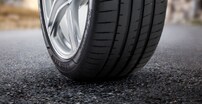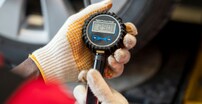Tire Basics
For the most enjoyable driving experience it's important to replace worn tires. Optimum traction helps provide responsive handling for a smooth, reliable ride.
To determine when you should start shopping, follow these simple steps:
1. GRAB A PENNY: First, test the tread. Pinch a penny between your thumb and forefinger, so that the top of Lincoln's head is showing.
2. TEST TIRE TREAD: Place the top of Lincoln's head into one of the tire tread grooves - try to measure in the deepest point within the tread.
3. WHAT DOES LINCOLN'S HEAD SHOW?: If any part of Lincoln's head is obscured by the tread, your tires have enough tread. However, if you can see above the head, you're ready for a new tire.
4. ADDITIONAL TESTS: You should always check your tires in several tread locations. Be sure to check the inner, outer, and middle grooves of each tire, as tires can wear differently on each side, due to improper wheel alignment and/or low inflation.
For professional help, visit a Goodyear store for a free inspection by our tire professionals.
- Look for tires that excel in tests for braking, handling.
- Let treadwear, ride comfort, noise, and rolling resistance help narrow your choices. (Goodyear's comparative tread-life tests demonstrate that a manufacturer's warranty doesn't always reflect how a tire will wear, but used as an estimate, it's an important piece of information)
- Choosing a vehicle tire depends on where you live, weather and terrain issues, what performance expectations you have, and what your vehicle requires.
We recommend installing four new tires, especially if you’re purchasing winter tires or tires for all-wheel drive vehicles. To help avoid premature treadwear and get the most out of your tires, replace all four tires at once and maintain a healthy rotation schedule (recommended every 6,000 miles).
If you do decide to buy just two new tires and they are the same size and construction of the tires already on your vehicle, you should install the new tires on the rear axle. Please note that you should never mix radial and bias-ply tires on the same axle. If you’re using radial tires with bias or bias-belted tires on the same vehicle, always place the radial tire on the rear axle. You should never mix tires with different speed ratings.
You can call us at 800-667-8138 if you have any questions about which tires are best for your situation.
You can buy online in a few quick steps:
1. ADD TO CART: Once you’ve found the right tire, you’ll be able to select a quantity and see installation pricing.
2. CHOOSE YOUR INSTALLER: Select from a list of trusted installers near you, and schedule your installation.
3. CHECK OUT: You’ll pay for your tires, installation, and taxes all up front.
4. HEAD TO THE INSTALLER: The tires will be waiting there, where they’ll be installed for you.









